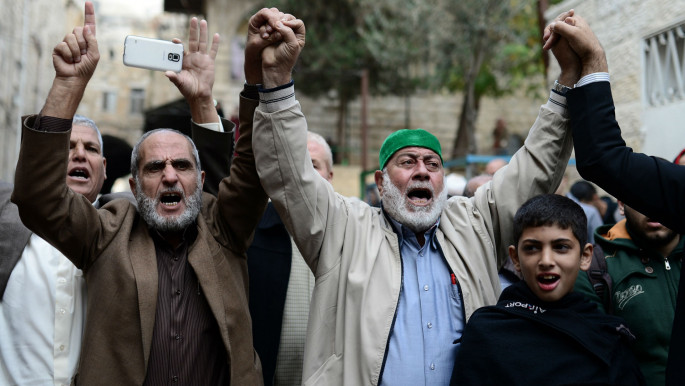
Jerusalem: A stricken apartheid city
Barkat’s 'open and united Jerusalem' of high-tech start-ups, marathons and international tourism has become a fortress city of surveillance balloons, running battles and protest.
5 min read
Jerusalem's Light Rail: a symbol of apartheid [AFP]
In the weeks and months after the Jerusalem Light Rail was inaugurated, city officials boasted of a practical achievement and powerful symbol of the city’s modernity and “unity”. Criticism that the line served illegal settlements was dismissed as ignorant. Pictures of Jewish and Palestinian passengers were proof positive, some suggested, of the deceit of the apartheid charge.
Yet in the fiery weeks of this year’s summer, the JLR became a different kind of symbol, as Palestinians focused their rage on its stations and trains as representative of Israel’s colonial domination.
| Stones and firecrackers are the new existential threat. |
This apartheid ‘capital’ is stricken, the lie of unity laid bare. Jewish extremists target the Aqsa mosque compound. There are routine clashes between Palestinian residents and occupation forces across the East of the city. In Silwan, radical settlers increase their presence and Palestinian homes are targeted for demolition.
Nir Barkat’s open and united Jerusalem of high-tech start-ups, marathons and international tourism has become a fortress city of surveillance balloons, running battles and protest. In the face of Palestinian resistance, the mayor has shown that it does not take much for his Western media-friendly sound bites to be swept aside by a discourse – and policy – of repression.
In recent days, Israel’s cabinet advanced legislation designed to slap draconian penalties on Palestinians protesters in Jerusalem. The amendment to the penal code would see a maximum prison sentence of 20 years for stone-throwers – including a 10-year term for offenders even when there is no proof of intent to harm.
Shortly after, reports circulated in the Israeli media that the Interior Ministry was looking at options for temporarily banning the import of the fireworks currently used by Palestinians against occupation forces. Stones and firecrackers are the new existential threat.
Note that it was actually in June that the Israeli government backed a US$86 million plan designed to thwart, in the words of Israeli newspaper Haaretz, “any possibility that [Jerusalem] would be divided as part of a future accord”. The origins of this plan came in ministerial discussions back in 2013 after an increase in “nationalistically motivated rock-throwing” and other incidents in East Jerusalem.
The plan was very much focused on “security”, and spoke of “uncompromising enforcement and punishment against those who seek to undermine Israeli control in [East Jerusalem]”. Aside from recommending changes in the penal code similar to those that are now being implemented, the plan also urged an intensification of police presence and surveillance measures.
Then, after the kidnap and murder of Mohammad Abu Khdeir in July, Palestinians took to the streets of East Jerusalem in a way not seen for some time. By late September, Israeli police said that they had arrested more than 700 Palestinians in East Jerusalem, including at least 250 minors. Palestinian unrest was also fuelled, of course, by anger at Israel’s bombardment of Gaza.
This systematic campaign of harassment and detention by the security forces was the frantic stamping of a man trying to put out smouldering dry grass: but the spark has not, for now, gone out. And this despite – or because of – the collective punishment meted out to Palestinian neighbourhoods such as Issawiya or Shuafat refugee camp. Police brutality, extraordinary bail conditions and night raids: Jerusalem looks more like Jenin than Tel Aviv.
 |
|
| The spark has not gone out [Anadolu] |
Then, as Gaza was pummelled by Israel’s drones, F-16s, artillery and tanks, popular protests in the West Bank were met with live ammunition. According to the UN, between 12 June and 31 August, Israel killed 27 Palestinians in the West Bank – five were children, and the youngest was just 11. According to a report by Ma’an news agency in mid-October, the death toll for the year in the West Bank stands at more than 40, with more than 4,300 injured.
Israel’s methods of repression in East Jerusalem and the West Bank adapt according to circumstances. In the First Intifada, stone-throwers had their arms broken; now, they will be thrown in a dungeon (if they haven’t been shot dead first). Palestinian resistance forces the Israeli occupation to show its hand. It is not one reaching out in partnership but rather a clenched fist demanding submission or punishment.
In Jerusalem, the catalyst may be the threat to al-Aqsa but make no mistake: the youth who confront the guns of the occupation do so having spent their entire lives watching their neighbourhoods fragmented and colonised, expected to be grateful for crumbs from the table. Bereft of political leadership, this is grassroots resistance whose roots go back through the struggles of past generations.
In East Jerusalem and the West Bank, Palestinians, especially youth, are confronting Israeli occupation forces and settlers with a new spirit of confidence and defiance. Israel’s methods of repression, whether from the Knesset, Interior Ministry, or through the barrel of a gun, can only achieve so much – and might, in fact, prove counter-productive.
This week I was reminded of those famous lines by Langston Hughes. “What happens to a dream deferred?” he asked. “Does it dry up like a raisin in the sun? Or fester like a sore - And then run? Does it stink like rotten meat? Or crust and sugar over - like a syrupy sweet? Maybe it just sags like a heavy load. Or does it explode?”
Ben White is a journalist and author of Israeli apartheid: A beginner’s guide
![Tensions in Jerusalem [AFP] Tensions in Jerusalem [AFP]](/sites/default/files/styles/large_16_9/public/media/images/E98DFD26-1681-4492-9539-2D3B9B466DAD.jpg?h=d1cb525d&itok=7hWhIpsm)




 Follow the Middle East's top stories in English at The New Arab on Google News
Follow the Middle East's top stories in English at The New Arab on Google News


